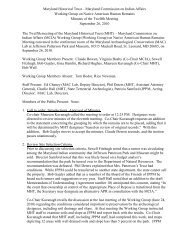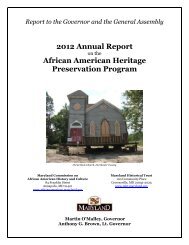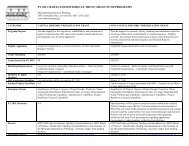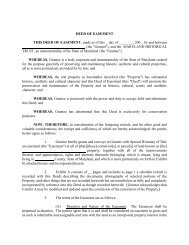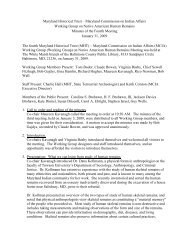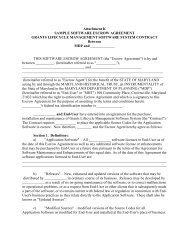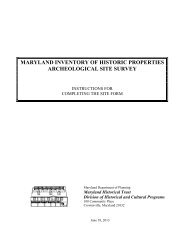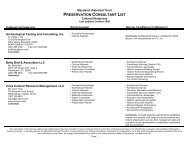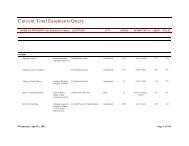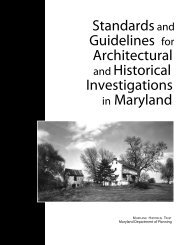<strong>The</strong> <strong>Maryland</strong> <strong>Preservation</strong> <strong>Plan</strong>, <strong>2005</strong>(except Baltimore City) is found in Article 66B, Section 8.01-8.17 of theAnnotated Code of <strong>Maryland</strong>. <strong>The</strong> enabling clause for charter counties (exceptMontgomery and Prince George’s) is Article 25A, Section (BB), for Montgomeryand Prince George’s County is Article 28, Section 101(c), and for BaltimoreCity is Article 66B, Section 2.12. Notably, certain tax benefits areavailable to owners of locally designated historic sites and of contributingresources within locally designated historic districts. As of <strong>2005</strong>, forty-fivejurisdictions had enacted local historic area zoning ordinances. Informationabout these communities is available on the MHT website.Both the Concord Point Lighthouse(above) in Havre de Grace and Rock RunMill (below) in Susquehanna State Parkare key sites in the Lower SusquehannaHeritage Greenway.Easton, Talbot County, was designatedas a Main Street community in November1997.<strong>The</strong> Rural Legacy Program seeks toprotect agricultural land like the JerichoFarm near Ellicott City in Howard County.Historic and Scenic RoadsHistoric and scenic roads are significant heritage resources both as keyelements of local landscapes and as tourism assets connecting cultural, historic,and natural attractions. Rural and scenic road protection programs havebecome increasingly popular in <strong>Maryland</strong> as communities haverecognized the important role historic transportation networks play in definingour sense of place. A number of local governments have surveyed their ruraland scenic roads, and in some cases implemented preservation programs,including Anne Arundel, Calvert, Charles, Frederick, Howard, Montgomery,Prince George’s, and St. Mary's counties.State and National Scenic Byways Programs, administered by the StateHighway Administration (SHA), can enhance local scenic road protectionprograms. Developed by SHA in conjunction with local tourism offices, Statescenic routes are then printed in booklet and map form for distribution. Allestablished State scenic routes are eligible to receive grant funds to produce acorridor management plan which must be developed in conjunction with localplanners, officials and residents. Local involvement is key to the nationalprogram, because there must be a provision in the county masterplan to maintainand protect the character of the route. Once the scenic route managementplan is approved, the route sponsor may apply for designation as a NationalScenic Byway. This designation makes the corridor eligible to apply for grantfunds to improve and promote the road.IV. SUGGESTIONS FOR IMPLEMENTINGSTATEWIDE GOALS FOR HERITAGERESOURCE CONSERVATION<strong>The</strong> following strategies are presented as suggestions for how State andlocal government officials, members of nonprofit organizations, and individualscan work to protect heritage resources throughout the State. <strong>The</strong>se are suggestionsonly and are not intended to mandate or dictate heritage resourceconservation practice.22
<strong>The</strong> Status of Heritage ResourcesGOAL 1: EFFECTIVELY MANAGE GROWTH BY ENCOURAGINGNEIGHBORHOOD REVITALIZATIONAll:• Recycle old buildings for commercial or residential uses.State agencies:• Send staff to visit one or two communities a monthand talk with merchants,otherbusinesspeople, and residents to determine theirconcerns, successes, and ideas about growthand how they feel it will affect their neighborhoodor community.• Ensure that the implementation of projects in“Designated Growth Areas” and neighborhoodrevitalization “Targeted Growth Areas” arecoordinated with MHT, the DHCD’sDivision of Neighborhood Revitalization, and otherState agencies.• Provide financial incentives for the preparation ofgrowth management plans to communities that arefacing increasing development pressure.• Offer technical assistance and GIS data to communitiesthat do not have advanced computer capabilities.Local governments:• Work with local merchants and other businesspeople to prepare and implement amarketing plan for the resources in your community.• Offer educational information and technical assistance about: facadeimprovements, interior renovation/rehabilitation, financing and marketing strategies,business retention and recruitment, above-store residential use, establishing asuccessful new business, and supporting incubator business programs.• Find new uses for old buildings: identify unused or underutilized buildings,prepare feasibility studies and marketing plans, determine housing and commercialneeds of community, identify outside influences (e.g., college expansion, newindustry, etc.) that have or will increase demand for residential and commercial units.• Provide incentive programs for rehabilitating historic structures through:property tax abatement or income tax credit programs, bartering, bonus heights ordensities, focused technical assistance, and grant and loan programs.• Include residents, businesspeople, preservationists, environmentalists, and localofficials as primary partners in developing your community’s comprehensive plans.• Ensure that plans for growth areas include design guidelines or standards fornew construction that are sympathetic to the environmental settings and characteristicsof surrounding historic properties.Nonprofit organizations:• Organize community clean-up days focusing on dilapidated or trash-strewn areas.• Adopt a family who needs assistance with rehabilitating their home, and organize agroup of volunteers that will provide free labor and supplies for completing the work.• Keep a directory of local vendors, contractors, and craftsmen who provide rehabilitationand maintenance services to historic buildings, and share the information withresidential and commercial property owners in your community.• Ensure that your organization has a voice in the local planning process by volunteeringto be a member of your jurisdiction’s community planning committee.• For local land trusts, initiate work with local and regional planners to ensure thatThirteen counties, thirty-one municipalities,and the City of Baltimore haveenacted local historic area zoningordinances. <strong>The</strong> following jurisdictionshave enacted local preservationordinances, as of <strong>2005</strong>: Annapolis,Baltimore City, Baltimore County, Bel Air,Berlin, Calvert County, Cambridge,Carroll County, Cecil County,Charlestown, Chesapeake City,Chestertown, Cumberland, Denton, EastNew Market, Easton, Frederick City,Frederick County, Frostburg,Gaithersburg, Hagerstown, HarfordCounty, Havre de Grace, HowardCounty, La Plata, Laurel, Laytonsville,Montgomery County, New Market,Oxford, Port Deposit, Prince George’sCounty, Princess Anne, Ridgely,Rockville, St. Mary’s County, St.Michaels, Salisbury, Snow Hill,Sykesville, Talbot County, WashingtonCounty, Westminster, Wicomico County23
- Page 1 and 2: THE MARYLANDPRESERVATION PLAN2005
- Page 3 and 4: THE MARYLAND HISTORICPRESERVATION P
- Page 6 and 7: The Maryland Preservation Plan, 200
- Page 8 and 9: The Maryland Preservation Plan, 200
- Page 10 and 11: The Maryland Preservation Plan, 200
- Page 12 and 13: The Maryland Preservation Plan, 200
- Page 14 and 15: The Maryland Preservation Plan, 200
- Page 16 and 17: The Maryland Preservation Plan, 200
- Page 18 and 19: The Maryland Preservation Plan, 200
- Page 20 and 21: The Maryland Preservation Plan, 200
- Page 22 and 23: The Maryland Preservation Plan, 200
- Page 24: The Maryland Preservation Plan, 200
- Page 29 and 30: The Status of Heritage Resources•
- Page 31 and 32: Suggestions for Implementing Statew
- Page 33 and 34: Suggestions for Implementing Statew
- Page 35 and 36: Selected Bibliographyagricultural a
- Page 37 and 38: Statewide Historic Contextszoos, an
- Page 39 and 40: Statewide Historic ContextsAmerican
- Page 41 and 42: Partners in Statewide Heritage Cons
- Page 43 and 44: Cover photo is courtesy of Tom Dard



